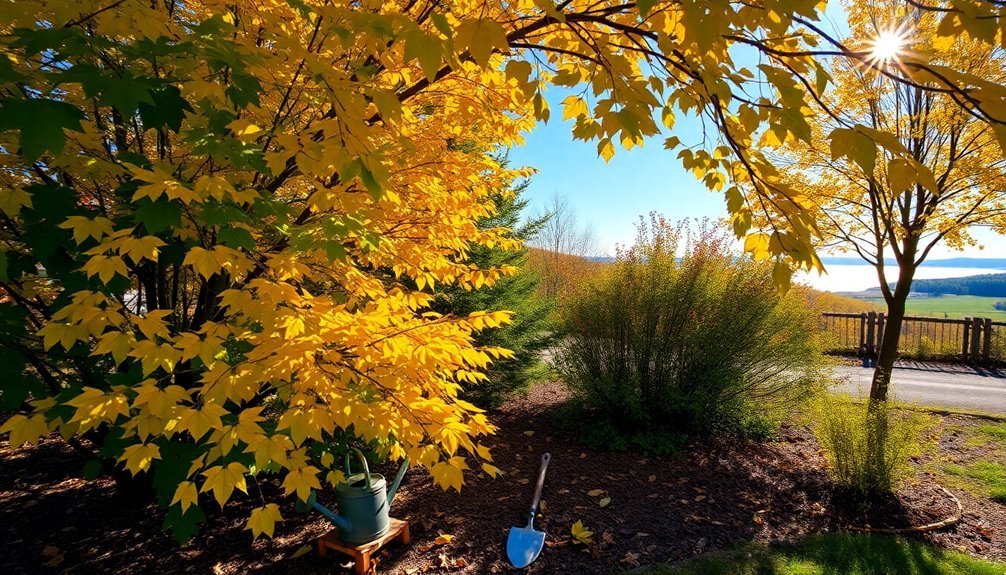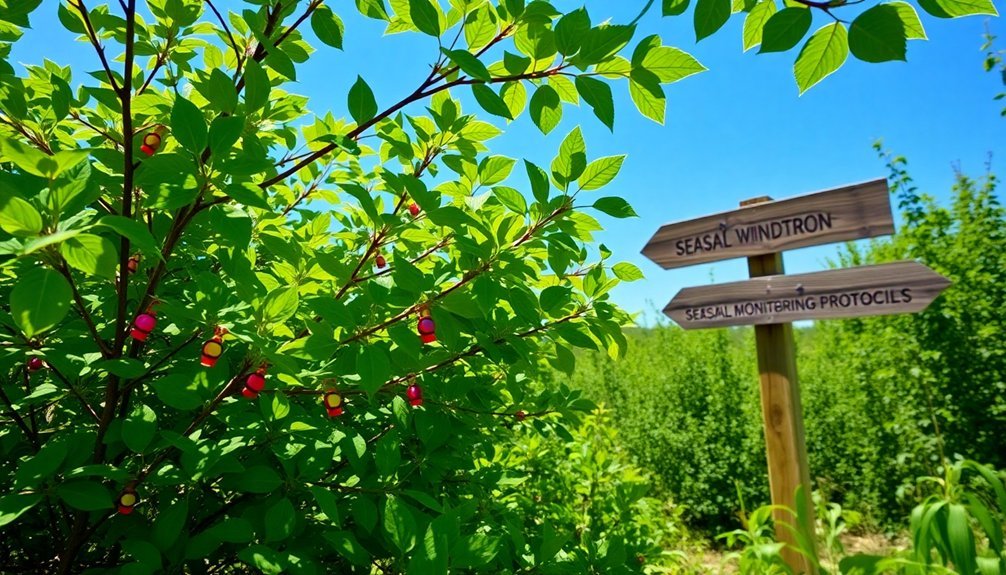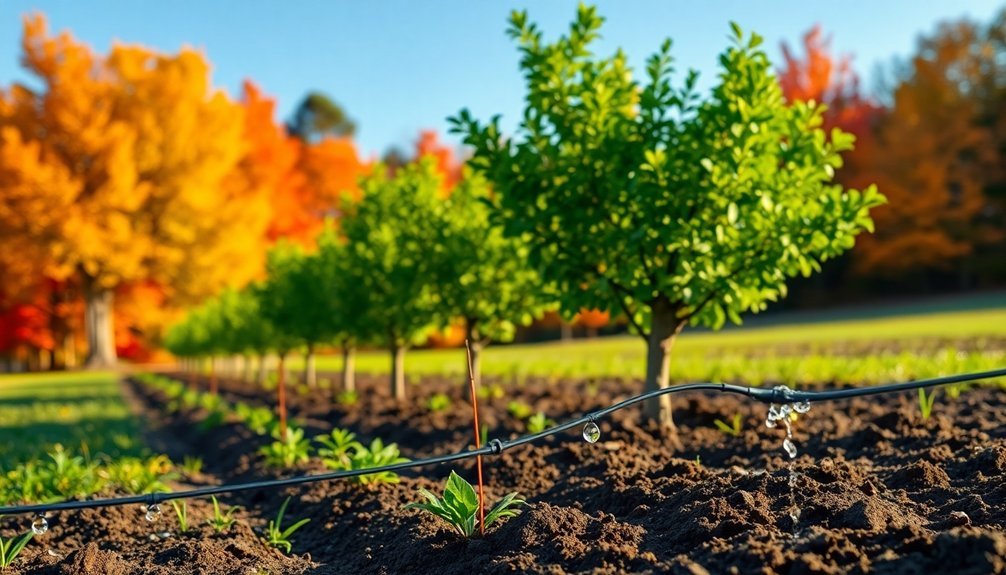Maintain your windbreaks year-round by inspecting for winter damage in spring, providing deep watering during summer dry spells, and applying mulch in fall. Prune strategically in winter, monitor for pests monthly, and diversify species when replacing trees. Protect root zones with 1-2 inches of organic mulch, secure mulch during windy periods, and adjust watering practices seasonally. Implementing these care practices guarantees your natural windbreak delivers decades of effective protection.
10 Tips for Seasonal Natural Windbreak Care

While many landowners focus on windbreak installation, proper seasonal maintenance is what truly determines long-term effectiveness. Your windbreak requires different care approaches throughout the year to maintain its protective function and ecological benefits.
In summer, prioritize regular pruning and pest monitoring while ensuring adequate water during dry spells. Apply mulch to retain moisture and suppress competing weeds.
Come autumn, inspect trees for disease, secure support structures, and manage leaf litter—either let it decompose naturally or mulch it to enrich the soil.
Winter demands strategic planning to manage snow distribution and protect young plants from harsh winds. Plant low shrubs on the windward side to trap snow effectively before it reaches your home. Incorporate diverse, wind-resistant species like Italian alder and sea buckthorn that are compatible with your soil conditions to create a resilient, wildlife-supporting barrier that remains effective year-round.
Spring Inspection: Assessing Winter Damage and New Growth
Begin your spring inspection immediately after the final frost to identify branches damaged by winter conditions and examine trees for early signs of insect activity.
As new shoots emerge, you'll need to monitor their growth pattern and vigor to guarantee your windbreak maintains proper density. Consider assessing the ground conditions around your windbreak for signs of erosion, weed overgrowth, or water pooling that might affect tree health.
Check these tender growths weekly, as they'll provide the first indicators of nutrient deficiencies or other health issues that require prompt attention.
Post-Frost Damage Assessment
As spring's warmth emerges, conducting a thorough post-frost damage assessment becomes crucial for maintaining healthy windbreaks.
Look for dry, brittle, and brown leaves—common indicators of frost exposure. Pay special attention to broadleaf evergreens, newly planted trees, and any container plants, as they're particularly vulnerable to winter injury.
Check soil moisture levels around your windbreak, as insufficient moisture often worsens frost damage.
Also examine for wind-related stress, which increases transpiration and compounds cold damage. Damage may be especially severe when experiencing high wind speeds similar to the coastal region's recent 15-20 mph winds with gusts reaching 50 mph.
Don't rush to prune affected areas immediately; many plants can recover naturally, with some requiring until June to show full recovery.
Wait until you see new growth before removing dead branches, which helps facilitate proper recovery and prevents potential disease issues.
Emerging Pest Identification
Once winter retreats, your vigilance against emerging pests becomes essential for windbreak health.
Wet spring conditions create ideal environments for Zimmerman pine moths, fungal pathogens, and soil-dwelling pests that target vulnerable trees.
Conduct monthly visual inspections using binoculars for high branches. Look specifically for tunneling under bark, needle drop, or signs of stress—pests typically attack already weakened trees.
Document any concerns with photos for expert consultation if needed.
Time your herbicide applications carefully, as weeds not only compete with trees but also harbor pests.
For effective management, implement IPM strategies combining cultural, biological, and chemical controls.
Look for soft, pinkish pitch masses on trunks and branches as these are clear infestation signs of Zimmerman pine moths that primarily target Ponderosa, Austrian, and Scotch pines.
Remove diseased branches promptly to improve air circulation and reduce disease pressure.
Remember that native species generally show better resilience to local pest pressures than exotic varieties.
New Shoot Monitoring
Spring's arrival signals the critical time to evaluate your windbreak's recovery from winter stresses. Focus on new shoots—they're indicators of your trees' health and vigor after winter dormancy.
Examine the density and distribution of emerging shoots across your windbreak. You'll want to look for any irregularities that might indicate underlying problems. Prune weak or damaged shoots to redirect energy to healthier growth. Consider installing additional temporary windbreaks around any particularly vulnerable sections showing slow recovery.
| Assessment Area | What to Look For | Action Needed |
|---|---|---|
| Shoot Vigor | Stunted or discolored growth | Apply appropriate nutrients |
| Pest Activity | Chewing damage, holes | Targeted pest control |
| Distribution | Uneven growth patterns | Assess for soil issues |
| Nutrient Signs | Yellow/purple leaves | Soil testing and amendments |
Document your observations for comparison with previous years—this record helps identify trends and recurring issues in your windbreak's health cycle.
Summer Drought Management for Windbreak Resilience
When summer drought threatens your windbreak, prioritize watering established trees showing stress signs like wilting or discoloration.
You'll maximize moisture retention by applying a 3-4 inch layer of organic mulch around each plant, keeping it several inches from trunks to prevent rot.
Preserve your mulch effectiveness by removing competing weeds regularly, especially during extended dry periods when competition for water becomes critical.
Remember that proper drought management helps maintain the windbreak's ability to reduce soil erosion and protect your valuable cropland during dry, windy conditions.
Water-Stressed Trees First
During extreme summer heat, your windbreak trees face their greatest survival challenge.
Prioritize trees showing yellowing leaves, wilting, or droopy branches—these are crying out for immediate attention.
Water during cooler hours (early morning or late evening) when evaporation rates are lowest.
For established trees, deep, infrequent watering encourages deeper root growth, while newly planted specimens need consistent moisture.
Consider your soil type; sandy soils require frequent watering, while clay soils need less frequent but deeper irrigation.
Install drip irrigation systems to deliver water directly to root zones, minimizing waste.
Young trees and shallow-rooted species should top your priority list when water is scarce.
Remember that proper mulching around trees (keeping it away from trunks) considerably reduces evaporation and helps maintain soil moisture between waterings.
Evergreen trees deserve special attention as they provide year-round protection against wind erosion and water loss in your fields.
Mulch Preservation Tactics
Effective mulch preservation becomes your windbreak's lifeline during summer drought conditions. Maintain a consistent 2-4 inch layer of organic materials like wood chips or bark around your trees, keeping it several inches away from trunks to prevent rot.
During windy periods, secure your mulch with appropriate anchoring methods such as netting to prevent displacement. Using plastic mulch has shown remarkable benefits with over 90% tree survival rates even in dry conditions, minimizing maintenance requirements. Regularly inspect mulched areas for degradation, weed growth, or debris accumulation, replenishing as needed to maintain effectiveness.
Your mulch serves multiple drought-fighting functions: conserving soil moisture, regulating temperature extremes, and reducing weed competition. By properly maintaining your mulch layer, you'll greatly reduce watering frequency while enhancing your windbreak's resilience against heat stress and pest infestations.
This preservation tactic integrates seamlessly with your overall windbreak maintenance strategy, supporting long-term tree health during challenging summer conditions.
Fall Preparation: Mulching and Protection Before Winter

As autumn leaves begin to fall, your windbreak requires specific care to withstand the upcoming winter challenges.
Apply 3-4 inches of mulch around newly planted trees to insulate roots from extreme temperatures and retain moisture. Organic options like wood chips add nutrients as they decompose, while inorganic materials offer longer-lasting protection.
Mulch serves as winter armor for young trees, insulating roots while feeding the soil with vital nutrients.
Don't neglect protection against harsh elements. Apply anti-desiccant sprays on your evergreens to prevent moisture loss, and prune damaged branches before ice and snow can cause further harm. This protective waxy coating will help minimize winter stress on your evergreen windbreak trees until spring arrives.
Remove debris that might harbor pests during winter months.
For next year's additions, order tree seedlings now for spring planting. Select diverse species, prioritizing evergreens for continuous winter protection, and verify they're suitable for your soil type and local conditions.
Winter Pruning Strategies for Stronger Windbreaks
Winter pruning success hinges on removing only the branches that compromise your windbreak's structure while preserving its density.
You'll want to complete all pruning tasks during late winter when trees are dormant, allowing them to heal properly before spring growth begins. Consider scheduling your maintenance on milder days when temperatures are less extreme to minimize additional stress on your windbreak plants.
Sanitize your tools between cuts to prevent disease transmission, focusing primarily on dead, damaged, or diseased branches rather than healthy growth.
Selective Branch Removal
Pruning selectively during winter months strengthens your windbreak's core structure while improving its overall resilience. Focus first on removing dead, diseased, or damaged branches, making clean cuts just outside the branch collar with sharp, sanitized tools to prevent disease spread.
When selecting branches for removal, prioritize those that create overcrowding or compromise the tree's natural form. Always support larger branches during cutting to prevent bark tearing and guarantee proper healing. Deciduous windbreak components provide better visibility during winter months, making structural assessment more effective.
| Branch Type | Removal Priority |
|---|---|
| Diseased/Damaged | Immediate |
| Crossing/Rubbing | High |
| Inward-growing | Medium |
| Water sprouts | As needed |
For young trees, more frequent selective pruning prevents structural issues later. Remember not to remove more than 25% of living branches at once to avoid stressing your windbreak trees.
Timing Matters Most
The ideal timing for windbreak maintenance can dramatically impact both tree health and protection efficiency. Late winter provides the best window for pruning your windbreak trees, minimizing storm damage risks and disease spread.
During winter dormancy, you'll find it easier to identify dead or damaged branches that need removal. This timing also stimulates robust spring growth, enhancing your windbreak's density and effectiveness.
You'll notice deciduous trees are particularly easy to assess with their bare branch structure clearly visible. Removing only damaged branches maintains structural integrity of your windbreak trees, as excessive pruning can decrease density and reduce the windbreak's effectiveness.
Strategic Thinning to Revitalize Aging Windbreaks

As aging windbreaks begin to lose their effectiveness, strategic thinning becomes essential for revitalizing their protective capabilities and extending their useful life.
Start by identifying areas of dense overgrowth and removing diseased or structurally unsound trees that pose safety hazards.
Select specific trees for removal to enhance structural integrity while maintaining the windbreak's protective function. Consider implementing this work in late winter when tree stress is minimal.
Don't forget to integrate pruning to manage canopy density and improve sunlight penetration.
After thinning, fill any gaps with new plantings and incorporate diverse species for greater resilience. Always consult with a professional forester before removing any trees to avoid creating long-term barriers in your windbreak.
Allow for natural regeneration where possible, but control competing weeds around new growth.
Regular inspections will help you evaluate the effectiveness of your thinning efforts.
Multi-Species Replacement Planning for Continuous Protection
Maintaining continuous wind protection requires thoughtful replacement planning before your existing windbreak deteriorates. Start by evaluating tree health and diversity, then select replacement species that complement your existing windbreak structure.
Plant new trees several years before removing old ones to guarantee uninterrupted protection. Consider native species with disease resistance and appropriate growth characteristics for your climate. Single-species windbreaks are more vulnerable to widespread disease and insect damage, so diversifying your plantings is highly recommended.
| Species Type | Benefits | Best Planting Season |
|---|---|---|
| Evergreens | Year-round protection | Early spring or fall |
| Fast-growing deciduous | Quick establishment | Dormant season |
| Shrub understory | Lower-level density | Spring after frost |
Maintain proper spacing between rows based on mature tree size, and implement a regular monitoring schedule. You'll need to control weeds around new plantings and provide supplemental water during establishment to guarantee successful integration into your windbreak system.
Seasonal Pest and Disease Monitoring Protocols

Regular monitoring of your windbreak throughout the year forms the foundation of effective pest and disease management.
Create a seasonal inspection schedule, checking for early signs of stress, unusual discoloration, or pest activity.
In spring, focus on detecting overwintering pests before they multiply.
Summer inspections should identify drought stress and active insect populations.
Fall monitoring helps prepare trees for winter by addressing weakened sections that might succumb to winter conditions. Consider applying natural repellents like peppermint oil around the base of trees to deter rodents that may damage your windbreak during colder months.
Implement IPM strategies rather than immediately reaching for chemical solutions.
Natural predators can reduce pest populations by targeting specific threats without harming beneficial insects.
When you detect disease, promptly prune affected sections and dispose of debris properly.
Remember that diverse species plantings create natural resilience, reducing the likelihood of widespread outbreaks affecting your entire windbreak.
Root Zone Management Throughout the Year
The foundation of a healthy windbreak lies beneath the surface, where root systems determine your trees' long-term survival and effectiveness. Maintaining proper soil moisture during the first growing season is critical, while ensuring your watering reaches at least 4 feet deep prevents shallow salt buildup that damages roots.
- Apply 1-2 inches of organic mulch around your trees to conserve moisture, suppress weeds, and gradually enhance soil fertility—but avoid heavy applications that can prevent water infiltration.
- Practice shallow cultivation (2-4 inches deep) when managing weeds to avoid damaging established root systems, and discontinue by late summer.
- Space your plants adequately to prevent root competition, and regularly assess root health by checking soil moisture levels and watching for signs of stress in foliage.
Adaptive Watering Techniques for Changing Seasons

As seasons shift throughout the year, your windbreak's watering needs change markedly to match environmental conditions.
Summer demands deeper, more frequent watering during cooler morning hours to combat evaporation and heat stress, while spring and fall require moderation.
Apply mulch in spring to retain moisture and repair any irrigation system damage.
Summer watering should focus on promoting deep root growth – essential for windbreak strength.
When fall arrives, reduce watering frequency as plants enter dormancy.
Before winter, thoroughly winterize your irrigation system by draining pipes, disconnecting hoses, and adding insulation to prevent freezing damage.
Throughout the year, monitor soil moisture levels and consult weather forecasts before watering.
Installing efficient drip irrigation and selecting native, drought-resistant species for your windbreak will markedly reduce water requirements.
Frequently Asked Questions
How Do Windbreaks Affect Property Value Over Time?
Windbreaks enhance your property value over time by improving aesthetics, providing protection from harsh weather, and supporting wildlife habitat. You'll see sustained benefits if you're maintaining diverse plantings and proper spacing regularly.
Can I Harvest Timber From My Windbreak Trees?
Yes, you can harvest timber from your windbreak, but plan carefully. Use rotational harvesting or selective cutting to maintain wind protection. Consult a forester for guidance on proper timing and species selection.
How Do Windbreaks Impact Snow Distribution Across Fields?
Windbreaks control snow distribution based on their porosity. You'll get ideal, even snow distribution with 60-70% porosity, while denser windbreaks create nearby drifts and very porous ones won't effectively retain snow across your fields.
Are There Tax Incentives for Maintaining Agricultural Windbreaks?
Yes, you'll find tax incentives through EQIP and NRCS programs that offer cost-sharing for windbreak maintenance. Contact your local USDA office to learn about specific reimbursements and conservation program benefits available in your region.
What Native Flowering Species Enhance Pollinator Presence in Windbreaks?
Native flowering species like willows, forsythia, flowering currant, black cherry, and dogwood enhance pollinator presence in windbreaks. You'll attract more beneficial insects by adding these plants to your windbreak design.
In Summary
Your natural windbreak isn't just a set-it-and-forget-it feature—it's a living system requiring seasonal attention. By following these care tips throughout the year, you'll maintain a robust, effective barrier that protects your property while enhancing its beauty. Remember, the small seasonal investments you're making now will pay dividends in windbreak performance and longevity for years to come.





Leave a Reply